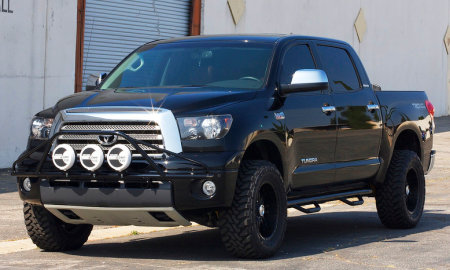Off-Road Tire Basics and Buyer’s Guide
Mark | Jun 24, 2009 | Comments 2
As with most specialty tires, when you’re looking to purchase a set of off-road tires, a lot of the knowledge you might have about standard street tires simply won’t apply. The tread styles, construction and size of off-road tires are quite different than what most people are used to, and it’s helpful to take a quick look at the basics of off-road tire design before heading to the local tire and wheel shop to have a set installed.
Almost everyone is familiar with the look of off-road tires – tall and aggressive. Even tires that are meant to fit on rims as small as 15 inches can be 30 or 33 inches in height (visit TireRack.com to see exactly which tire sizes will fit on your Tundra). A common misconception with larger tires is that the giant sizes are meant to provide extra grip and traction. While there is an off-road benefit in a tall sidewall (especially when you make the tire pressure artificially low), the main benefit to over-sized tires is that they get your truck up in the air as much as possible and boost ground clearance.
When it comes to boosting traction, there are two aspects of off-road tire design to consider: tread type and tire construction. Generally speaking, most trail tires feature very knobby treads that are noisy on pavement. The treads on these tires can even sometimes extend into the sidewall, and just how wild the “canyons and gaps” in the tire tread are depends on how specialized of a tire you’re looking at. All-terrain tires are more of a compromise and are meant to be used in a wider variety of off-road conditions, while focused mud or rock-climbing tires often display more radical patterns.
In terms of construction, off-road tires are either of a bias ply design or standard radial design. Bias ply tires faded from the nation’s highways in the 1970’s due to the increased durability and quality of steel-belted radials. However, the ability of a bias ply tire to perform when inflated to a very low level (ideal for deep sand, rock-crawling, and more) makes them a popular choice amongst off-road drivers. Low inflation pressures allow a tire to spread out more and provide greater traction, and the bias ply design also helps a tire to better absorb blows from hard surfaces and sharp rocks. Bias ply tires are constructed from a softer rubber compound, which allows for greater grip than radial tires (assuming similar tread patterns).
However, before you go out and buy a set of bias ply tires, know that radial off-road tires can usually provide nine tenths of the off-road performance offered by a bias ply tire while also being safer and more predictable on the pavement. In fact, if you’re pulling “double duty” in your pickup (i.e. using it for both fun and work), stick with radials.
When deciding on which off-road tire to purchase for your truck, it’s important to consider just how much a new type of tire can change your driving experience:
- Most off-road tread patterns are loud when driven on pavement, sometimes significantly so at highway speeds.
- Speaking of the highway, most off-road tires aren’t meant for hours and hours of use on the interstate. In fact, sustained highway use is the easiest way to ruin quality off-road tires.
- Off-road tires aren’t always effective on wet pavement. Large tread blocks aren’t necessarily good for wet-weather traction.
- “Handling” and off-road tires don’t go together. If you like taking corners fast, off-road tires aren’t your thing.
- A good set of knobby off-road tires will reduce your trucks fuel economy by 1-2 mpg.
If you’re interested in off-road tires but you also have to drive your truck to work every day, you might consider buying a second set of rims and having a good set of off-road tires mounted on them. Having a second set of wheels opens up a wider range of possibilities, as you can choose to go with a more extreme tire on your “weekend wheels” without having to worry about how off-road tires will effect your truck’s performance on a daily basis.
Surprisingly, a second set of wheels doesn’t have to be tremendously expensive. Coming up, we’ll have some tips and strategies for buying a second set of truck wheels on the cheap.
Filed Under: Toyota Tundra Accessories



got the bfg ta’s . the way to go if u want that in between compromise of decent off road , good in the snow and good on the road
What wheel is that Todd